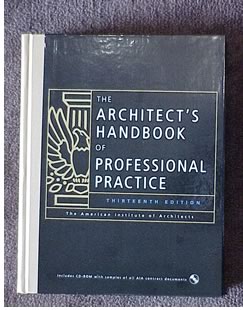
The first thing you'll notice about the new edition is that it is one bound publication (and fairly substantial, at over 1,000 pages), a departure from the three-ring-binder format of the last two editions. It still has all the firm-, liability-, and financial-management details (all thoroughly updated) you've come to expect from the Handbook. The extensive explanation of the AIA contract documents are all new as well.
The biggest change you'll find inside, then, is that there are two entirely new sections. Sandwiching the updated material are an opening section on understanding the client and a back section on expanded services every architect should be considering to meet the marketplace today and in the coming years.
 Paradigm
shift in thinking
Paradigm
shift in thinking
This new issue of the Handbook,
which has been in publication for 80 years, significantly updates the
12th edition (published in 1994) to address the challenges of rapidly
advancing technology, explosive growth of information, an expanding global
economy, and intense market competition.
Most significantly, the new edition explains the practice of architecture as a knowledge-based and service-oriented endeavor. Successful firms recognize that clients find value in the wisdom the architect provides, not just the construction documents. To explain the emerging redefinition of client/architect relations, the 13th edition begins with a new section devoted to understanding client motivation, thinking, processes, and values.
Chapters in the 13th edition fall into four sections:
• "Client" explores how clients are motivated, how they
think, what they value, and how architects can build stronger relationships
with existing and new clients
• "Business," addresses support functions vital to architectural
practice
• "Delivery" presents processes that define, obligate,
and deliver professional services
• "Services" profiles a range of core and expanded services
with which architects can respond to all of a client's facility-related
needs, including those beyond the design and creation of physical space.
New-format text and
CD-ROM
Compiled by a team whose collective expertise spans architecture, law,
business, firm management, marketing, and consulting, the new Handbook
comes accompanied by a CD-ROM that contains reference samples of 75 AIA
contract documents.
The new edition includes pointers that lead to related material in the Handbook; reference markers for related resources from the Institute; capsulized information from the AIA Firm Survey, 2000–2002; notes amplifying ideas and sources for further information; and quotations providing insight from noted architects and other luminaries.
The Handbook targets licensed architects with at least 5 to 10 years in practice. However, interns, architecture students, and professionals who work with architects also find the Handbook invaluable.
Copyright 2001 The American Institute of Architects. All rights reserved.
![]()